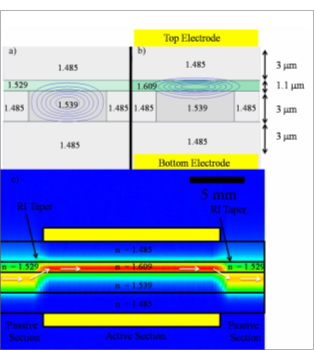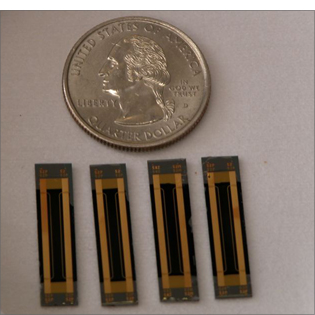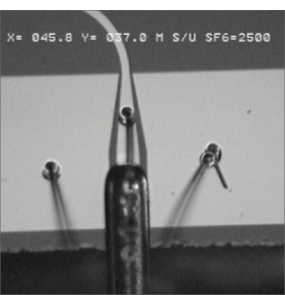Electro-optic Polymer Modulators
The continuing explosive growth of the Internet, wireless communication of many forms, and digital storage technology is creating a growing need for high performance, compact, low power consumption and low cost optical devices.
The fundamental operation of translating an electrical input signal to the optical domain can be done by directly modulating the laser transmitter, or, increasingly, by using an external modulator that acts like an ultrafast shutter that can be turned on and off in fractions of a nanosecond.
We have been pursuing an approach to external modulation that makes use of state-of-the-art modulation materials, electro-optic polymers, together with high performance passive optical materials such as sol-gels and ion exchange glass. One of the designs that we have recently employed is shown below; essentially the device interfaces to optical fiber through a sol-gel waveguide, which then transfers its energy to an electro-optic polymer waveguide through an adiabatic taper. After modulation the light is then transferred back to the sol-gel waveguide for subsequent coupling to the output optical fiber.

Devices employing this geometry and various variations have been made using excellent current generation EO polymers with electro-optic coefficients in the range of 50-100pm/V; in one instance a material exhibiting an in-device EO coefficient of 170pm/V was made and to our knowledge this is one of the highest EO coefficients of demonstrated in a device geometry. Typical waveguide chips are shown below; the chips are typically 1 to 2 cm in length and about 0.5 cm or less wide. Half-wave voltages in the range of 0.65 to the 3V and insertion losses in the range of 5dB to 12dB, depending on the designs and materials used.

We are now developing advanced packaging techniques for high speed modulators, such as high precision wirebonding, as shown below. Optimized fiber attachment procedures have been developed and demonstrated to provide robust performance with minimal excess optical loss (few tenths of a dB).

Future work will increasingly focus on the integration of EO polymers with nanophotonic device platforms such as silicon-on-insulator. A Y-splitter employing photonic crystal techniques is shown; this approach allows for the fabrication of ultracompact splitters a few microns long, as compared to ordinary Y-junctions which must be millimeters in length to achieve low optical loss.
References
- C. T. DeRose, R. Himmelhuber, D. Mathine, R. A. Norwood, J. Luo, A. K.-Y. Jen, and N. Peyghambarian, “High delta n strip loaded electro-optic polymer waveguide modulator with low insertion loss,” Optics Express 17, 3316 (2009).
- C. T. DeRose, D. Mathine, Y. Enami, R. A. Norwood, J. Luo, A. K.-Y. Jen, and N. Peyghambarian, “Electro-optic polymer modulator with single-mode to multimode waveguide transitions,” IEEE Phot. Tech. Lett. 20, 1051 (2008).
- Y. Enami, D. Mathine, C. T. DeRose, R. A. Norwood, J. Luo, A. K.-Y. Jen, and N. Peyghambarian, “Transversely tapered hybrid electro-optic polymer/sol-gel Mach-Zehnder waveguide modulators,” Applied Physics Letters 92, 193508 (2008).
- Y. Enami, D. Mathine, C. T. DeRose, R. A. Norwood, J. Luo, A. K.-Y. Jen, and N. Peyghambarian, “Hybrid cross-linkable polymer/sol-gel waveguide modulators with 0.65 half-wave voltage at 1550nm,” Applied Physics Letters 91, 093505 (2007).
- R. A. Norwood, C. DeRose, Y. Enami, H. Gan, C. Greenlee, R. Himmelhuber, O. Kropachev, C. Loychik, D. Mathine, Y. Merzylak, M. Fallahi, and N. Peyghambarian, “Hybrid sol-gel electro-optic polymer modulators: Beating the drive voltage/loss tradeoff,” J. Nonlinear Optical Physics & Materials 16, 217 (2007).
- Y. Enami, C. T. DeRose, C. Loychik, C. Greenlee, D. Mathine, R. A. Norwood, T. D. Kim, J. Luo, Y. Tian, A. K.-Y. Jen, and N. Peyghambarian, “Hybrid polymer/sol-gel waveguide modulators with exceptionally large electro-optic coefficients,” Nature Photonics 1, 180 (2007).
- Y. Enami, C. T. DeRose, C. Loychik, D. Mathine, R. A. Norwood, J.Luo, A. K.-Y. Jen, and N. Peyghambarian, “Low half-wave voltage and high electro-optic effect in hybrid polymer/sol-gel waveguide modulators,” Applied Physics Letters 89, 143506 (2006).
- C. T. DeRose, Y. Enami, C. Loychik, R. A. Norwood, D. Mathine, M. Fallahi, N. Peyghambarian, J. D. Luo, A. K.-Y. Jen, M. Katheperumal, and M. Yamamoto, “Pockel’s coefficient enhancement of poled electro-optic polymers with a hybrid organic-inorganic sol-gel cladding layer,” Applied Physics Letters 89, 131102 (2006).

